 Every time you take your blood pressure, write down the date and time, the blood pressure measurement, and where it was taken (home, doctor’s office, etc.). Not only that, but include any comments your health care provider made and anything you would like to note, such as how you feel or medications you recently started or stopped. This 2-page fact sheet was written by Linda B. Bobroff and Leigh Ann Martin, and published by the UF Department of Family Youth and Community Sciences, October 2013.
Every time you take your blood pressure, write down the date and time, the blood pressure measurement, and where it was taken (home, doctor’s office, etc.). Not only that, but include any comments your health care provider made and anything you would like to note, such as how you feel or medications you recently started or stopped. This 2-page fact sheet was written by Linda B. Bobroff and Leigh Ann Martin, and published by the UF Department of Family Youth and Community Sciences, October 2013.
http://edis.ifas.ufl.edu/fy662
Author: dihagan
Understanding the New School Meal Standards
 If you have school-age children, you may have heard that the 2012 school year brought major changes to the meals children eat at school. All meals provided through the School Breakfast and National School Lunch Programs now must be consistent with the USDA’s Dietary Guidelines for Americans. This 6-page fact sheet was written by Jenna Norris, Karla P. Shelnutt, and Gail P. A. Kauwell, and published by the UF Department of Family Youth and Community Sciences, October 2013.
If you have school-age children, you may have heard that the 2012 school year brought major changes to the meals children eat at school. All meals provided through the School Breakfast and National School Lunch Programs now must be consistent with the USDA’s Dietary Guidelines for Americans. This 6-page fact sheet was written by Jenna Norris, Karla P. Shelnutt, and Gail P. A. Kauwell, and published by the UF Department of Family Youth and Community Sciences, October 2013.
http://edis.ifas.ufl.edu/fy1396
Eating Defensively: The Nutrition and Food Safety Benefits of Cooked Produce
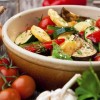 Current nutrition trends such as the “raw food diet” may lead consumers to believe that raw leafy vegetables are more nutritious than cooked vegetables, despite research showing that cooked vegetables make important nutritional contributions. This publication describes the nutrient retention and quality of cooked vegetables, explains why cooking vegetables is appropriate for consumers with food safety concerns, and provides tips for preparing cooked vegetables. This 4-page fact sheet was written by Morgan Dehnard, Amy Simonne, and Gail P. A. Kauwell, and published by the UF Department of Family Youth and Community Sciences, October 2013.
Current nutrition trends such as the “raw food diet” may lead consumers to believe that raw leafy vegetables are more nutritious than cooked vegetables, despite research showing that cooked vegetables make important nutritional contributions. This publication describes the nutrient retention and quality of cooked vegetables, explains why cooking vegetables is appropriate for consumers with food safety concerns, and provides tips for preparing cooked vegetables. This 4-page fact sheet was written by Morgan Dehnard, Amy Simonne, and Gail P. A. Kauwell, and published by the UF Department of Family Youth and Community Sciences, October 2013.
http://edis.ifas.ufl.edu/fy1395
An Overview of Life Insurance
 The primary purpose for buying life insurance is to protect the people who depend on you. A life insurance policy can help to ensure your family’s financial needs are met even after your untimely death. Life insurance can also provide a way to leave a cash gift to your spouse, children, grandchildren, or charities. Once you decide to buy a life insurance policy, you will have a few decisions to make. You will need to select among the different types of life insurance, decide on a dollar amount, and name your beneficiaries. In this publication, you will learn about the different types of life insurance and the ways to determine the amount of life insurance you may need. This 4-page fact sheet was written by Lisa Leslie and Martie Gillen, and published by the UF Department of Family Youth and Community Sciences, October 2013.
The primary purpose for buying life insurance is to protect the people who depend on you. A life insurance policy can help to ensure your family’s financial needs are met even after your untimely death. Life insurance can also provide a way to leave a cash gift to your spouse, children, grandchildren, or charities. Once you decide to buy a life insurance policy, you will have a few decisions to make. You will need to select among the different types of life insurance, decide on a dollar amount, and name your beneficiaries. In this publication, you will learn about the different types of life insurance and the ways to determine the amount of life insurance you may need. This 4-page fact sheet was written by Lisa Leslie and Martie Gillen, and published by the UF Department of Family Youth and Community Sciences, October 2013.
http://edis.ifas.ufl.edu/fy1393
Preventing Foodborne Illness: E. coli O157:H7
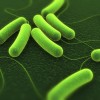 Escherichia coli is a bacterium found in the digestive system of healthy humans and animals and transmitted through fecal contamination. There are hundreds of known E. coli strains, with E. coli O157:H7 being the most recognized. This enterohemorrhagic E. coli (or EHEC) strain is responsible for an estimated 63,153 cases of infection and 20 deaths in the United States annually, and causes approximately $255 million in losses each year. E. coli are found everywhere in the environment but mostly occupy animal surfaces and digestive systems, making it important to thoroughly wash anything that comes into contact with these surfaces. This 5-page fact sheet was written by Keith R. Schneider, Renée Goodrich Schneider, Michael A. Hubbard, and Alexandra Chang, and published by the UF Department of Food Science and Human Nutrition, October 2013.
Escherichia coli is a bacterium found in the digestive system of healthy humans and animals and transmitted through fecal contamination. There are hundreds of known E. coli strains, with E. coli O157:H7 being the most recognized. This enterohemorrhagic E. coli (or EHEC) strain is responsible for an estimated 63,153 cases of infection and 20 deaths in the United States annually, and causes approximately $255 million in losses each year. E. coli are found everywhere in the environment but mostly occupy animal surfaces and digestive systems, making it important to thoroughly wash anything that comes into contact with these surfaces. This 5-page fact sheet was written by Keith R. Schneider, Renée Goodrich Schneider, Michael A. Hubbard, and Alexandra Chang, and published by the UF Department of Food Science and Human Nutrition, October 2013.
http://edis.ifas.ufl.edu/fs097
Preventing Foodborne Illness: E. coli “The Big Six”
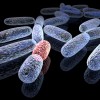 Escherichia coli is a bacterium usually found in the digestive system of healthy humans and animals and transmitted through fecal contamination. There are hundreds of known E. coli strains, with E. coli O157:H7 being the most widely recognized because of the severe illness it causes. In addition to E. coli O157:H7, the U.S. Food and Drug Administration has identified six serogroups (or “strains”), known as the “big six,” which includes E. coli O26, O45, O103, O111, O121, and O145. These are the most commonly seen types of E. coli found in food in the United States that are not O157:H7, and they cause approximately 37,000 cases per year in the United States. This 5-page fact sheet was written by Susanna Richardson, Renée Goodrich Schneider, and Keith R. Schneider, and published by the UF Department of Food Science and Human Nutrition, October 2013.
Escherichia coli is a bacterium usually found in the digestive system of healthy humans and animals and transmitted through fecal contamination. There are hundreds of known E. coli strains, with E. coli O157:H7 being the most widely recognized because of the severe illness it causes. In addition to E. coli O157:H7, the U.S. Food and Drug Administration has identified six serogroups (or “strains”), known as the “big six,” which includes E. coli O26, O45, O103, O111, O121, and O145. These are the most commonly seen types of E. coli found in food in the United States that are not O157:H7, and they cause approximately 37,000 cases per year in the United States. This 5-page fact sheet was written by Susanna Richardson, Renée Goodrich Schneider, and Keith R. Schneider, and published by the UF Department of Food Science and Human Nutrition, October 2013.
http://edis.ifas.ufl.edu/fs233
MiPlato Serie 10 Consejos de Educación en Nutrición
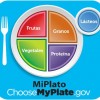 Despues de introducir MiPlato en junio de 2011, el Departamento de Agricultura de los EEUU (USDA) desarolló una seria de hojas informativas para ayudar a los consumidores utilizar los consejos dietéticos de los Pautas Dietéticas de 2010. En 2013, el USDA comenzó proveer las hojas de consejos en Español. Estas hojas de consejos se distribuyen por el UF/IFAS para la facultad de Extensión, los profesionales de salud, y los consumidores. This 33-page fact sheet was written by USDA Centro para Políticas y Promoción de la Nutrición, con una introducción por Linda B. Bobroff, and published by the UF Department of Family Youth and Community Sciences, October 2013.
Despues de introducir MiPlato en junio de 2011, el Departamento de Agricultura de los EEUU (USDA) desarolló una seria de hojas informativas para ayudar a los consumidores utilizar los consejos dietéticos de los Pautas Dietéticas de 2010. En 2013, el USDA comenzó proveer las hojas de consejos en Español. Estas hojas de consejos se distribuyen por el UF/IFAS para la facultad de Extensión, los profesionales de salud, y los consumidores. This 33-page fact sheet was written by USDA Centro para Políticas y Promoción de la Nutrición, con una introducción por Linda B. Bobroff, and published by the UF Department of Family Youth and Community Sciences, October 2013.
http://edis.ifas.ufl.edu/fy1399
Fall Prevention: Lifestyle Factors and Fall Risk
 Many things can cause you to fall. The good news is that you can make some easy changes to decrease your risk of falling. This 2-page fact sheet was written by Linda B. Bobroff and Jennifer Hillan, and published by the UF Department of Family Youth and Community Sciences, October 2013.
Many things can cause you to fall. The good news is that you can make some easy changes to decrease your risk of falling. This 2-page fact sheet was written by Linda B. Bobroff and Jennifer Hillan, and published by the UF Department of Family Youth and Community Sciences, October 2013.
http://edis.ifas.ufl.edu/fy736
Key to Common Bay Trees of Florida
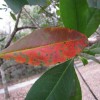 Bay trees in Florida can be difficult to distinguish because their leaves all look alike at first glance. The leaves of bays are all simple, large, elliptical, and evergreen. In addition, several bay species grow in overlapping ranges and habitats. Many times two or more different species of bay will be found growing right next to one other. This 7-page fact sheet includes a dichotomous key to help in the identification of common bay trees found in Florida. A basic description and photos of each species help with the identification process. Written by Lynn Proenza and Michael Andreu, and published by the UF Department of School of Forest Resources and Conservation, September 2013.
Bay trees in Florida can be difficult to distinguish because their leaves all look alike at first glance. The leaves of bays are all simple, large, elliptical, and evergreen. In addition, several bay species grow in overlapping ranges and habitats. Many times two or more different species of bay will be found growing right next to one other. This 7-page fact sheet includes a dichotomous key to help in the identification of common bay trees found in Florida. A basic description and photos of each species help with the identification process. Written by Lynn Proenza and Michael Andreu, and published by the UF Department of School of Forest Resources and Conservation, September 2013.
http://edis.ifas.ufl.edu/fr379
Inclusion of Diverse Learners in the Educational System
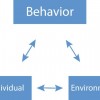 Every student in the United States has the right to an education. But not every student is ready, prepared, or willing to learn. Teachers trying to fully engage students in the learning environment can find it difficult when working with students from diverse backgrounds. Forms of diversity such as socioeconomic status, ethnicity/race, learning style, cognitive ability, gender, and ability to process and store knowledge can cause an “achievement gap” between students. This 4-page fact sheet highlights effective educational strategies for engaging students in the learning environment and assisting in closing achievement gaps. Written by Eric D. Rubenstein and Andrew C. Thoron, and published by the UF Department of Agricultural Education and Communication, July 2013.
Every student in the United States has the right to an education. But not every student is ready, prepared, or willing to learn. Teachers trying to fully engage students in the learning environment can find it difficult when working with students from diverse backgrounds. Forms of diversity such as socioeconomic status, ethnicity/race, learning style, cognitive ability, gender, and ability to process and store knowledge can cause an “achievement gap” between students. This 4-page fact sheet highlights effective educational strategies for engaging students in the learning environment and assisting in closing achievement gaps. Written by Eric D. Rubenstein and Andrew C. Thoron, and published by the UF Department of Agricultural Education and Communication, July 2013.
http://edis.ifas.ufl.edu/wc150
Conserving Urban Wildlife in the Face of Climate Change
 Virtually all climatologists agree that humans are increasing the rate of the Earth’s warming by releasing greenhouse gases into the atmosphere. But you might be surprised to learn that houses and residential neighborhoods are sources greenhouse gases of carbon because everything in a house that runs on electricity or gas is often derived from burning fossil fuels. This 4-page fact sheet describes the connections between climate change, wildlife, and human neighborhoods and presents several ways for residents to live more sustainably. Written by Daniel Feinberg and Mark Hostetler, and published by the UF Department of Wildlife Ecology and Conservation, September 2013.
Virtually all climatologists agree that humans are increasing the rate of the Earth’s warming by releasing greenhouse gases into the atmosphere. But you might be surprised to learn that houses and residential neighborhoods are sources greenhouse gases of carbon because everything in a house that runs on electricity or gas is often derived from burning fossil fuels. This 4-page fact sheet describes the connections between climate change, wildlife, and human neighborhoods and presents several ways for residents to live more sustainably. Written by Daniel Feinberg and Mark Hostetler, and published by the UF Department of Wildlife Ecology and Conservation, September 2013.
http://edis.ifas.ufl.edu/uw381
Smartirrigation Apps: Urban Turf
 We developed an app called Smartirrigation Turf to provide an easy-to-use mobile tool that delivers information to improve irrigation scheduling for urban turf. Using the app instead of a set time-based schedule for irrigation, homeowners and others can provide irrigation amounts to turf that more closely match water needs. This version of the app is applicable in Florida and Georgia and is available to download in the Apple App Store and Google Play Store. This 5-page fact sheet was written by K. W. Migliaccio, J. H. Debastiani Andreis, C. Fraisse, K. T. Morgan, and G. Vellidis, and published by the UF Department of Agricultural and Biological Engineering, October 2013.
We developed an app called Smartirrigation Turf to provide an easy-to-use mobile tool that delivers information to improve irrigation scheduling for urban turf. Using the app instead of a set time-based schedule for irrigation, homeowners and others can provide irrigation amounts to turf that more closely match water needs. This version of the app is applicable in Florida and Georgia and is available to download in the Apple App Store and Google Play Store. This 5-page fact sheet was written by K. W. Migliaccio, J. H. Debastiani Andreis, C. Fraisse, K. T. Morgan, and G. Vellidis, and published by the UF Department of Agricultural and Biological Engineering, October 2013.
http://edis.ifas.ufl.edu/ae499
The Green Value of Your Woods: A Summary of Ecosystem Services Provided by Forest Stewardship Lands in Florida
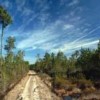 Lands enrolled in voluntary forest management and conservation programs, like the Forest Stewardship Program, promote good land management practices. In addition to benefiting the landowners enrolled in these programs, good land management provides ecosystem services to society. The Stewardship Ecosystem Services Survey calculated the physical and economic benefits of water resource protection, carbon sequestration and storage, timber production, and wildlife conservation. This 2-page fact sheet was written by Rose Godfrey, Chris Demers, Francisco Escobedo, Damian Adams, and Michael Andreu, and published by the UF Department of School of Forest Resources and Conservation, September 2013.
Lands enrolled in voluntary forest management and conservation programs, like the Forest Stewardship Program, promote good land management practices. In addition to benefiting the landowners enrolled in these programs, good land management provides ecosystem services to society. The Stewardship Ecosystem Services Survey calculated the physical and economic benefits of water resource protection, carbon sequestration and storage, timber production, and wildlife conservation. This 2-page fact sheet was written by Rose Godfrey, Chris Demers, Francisco Escobedo, Damian Adams, and Michael Andreu, and published by the UF Department of School of Forest Resources and Conservation, September 2013.
http://edis.ifas.ufl.edu/fr381
Pesticide Applicator Certification and Training
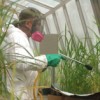 Certification is a process that allows a person to qualify to use pesticides in the course of his or her occupation. In Florida, the Florida Department of Agriculture and Consumer Services (FDACS) administers the certification process. Training provides instruction on proper pesticide use and handling to individuals who want to obtain or retain certification. In Florida, UF/IFAS Extension primarily conducts pesticide training, but other associations, industry, non-profit organizations, private companies, and federal and state government agencies also provide and assist with training. This 3-page fact sheet was written by F. M. Fishel, and published by the UF Department of Agronomy, October 2013.
Certification is a process that allows a person to qualify to use pesticides in the course of his or her occupation. In Florida, the Florida Department of Agriculture and Consumer Services (FDACS) administers the certification process. Training provides instruction on proper pesticide use and handling to individuals who want to obtain or retain certification. In Florida, UF/IFAS Extension primarily conducts pesticide training, but other associations, industry, non-profit organizations, private companies, and federal and state government agencies also provide and assist with training. This 3-page fact sheet was written by F. M. Fishel, and published by the UF Department of Agronomy, October 2013.
http://edis.ifas.ufl.edu/pi247
Integrated Pest Management in Protected Structures I: Basic Principles and Scouting
 The fundamentals of managing pests in protected structures are very similar in many respects to managing pests in field crops. But conditions within a protected structure can be modified to a certain degree to prevent, delay, or even mitigate pest issues. On the other hand, conditions that discourage one group of pests can often favor another. This 7-page fact sheet was written by Hugh A. Smith, Gary E. Vallad, and Bielinski M. Santos, and published by the UF Department of Entomology and Nematology, June 2013.
The fundamentals of managing pests in protected structures are very similar in many respects to managing pests in field crops. But conditions within a protected structure can be modified to a certain degree to prevent, delay, or even mitigate pest issues. On the other hand, conditions that discourage one group of pests can often favor another. This 7-page fact sheet was written by Hugh A. Smith, Gary E. Vallad, and Bielinski M. Santos, and published by the UF Department of Entomology and Nematology, June 2013.
http://edis.ifas.ufl.edu/in994
2013 Cotton Defoliation and Harvest Aid Guide
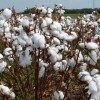 In Florida, cotton requires about 155 days of growth from planting to harvest. Throughout the growing season, growers must make important management decisions about defoliation, boll opening, and regrowth suppression. These factors can affect the quality and storage time if the crop is put into modules. The greatest losses in quality are caused by stain from poorly defoliated plants or regrowth and moisture from green tissue. This 8-page fact sheet was written by R.G. Leon, D. L. Wright and B. J. Brecke, and published by the UF Department of Agronomy, October 2013.
In Florida, cotton requires about 155 days of growth from planting to harvest. Throughout the growing season, growers must make important management decisions about defoliation, boll opening, and regrowth suppression. These factors can affect the quality and storage time if the crop is put into modules. The greatest losses in quality are caused by stain from poorly defoliated plants or regrowth and moisture from green tissue. This 8-page fact sheet was written by R.G. Leon, D. L. Wright and B. J. Brecke, and published by the UF Department of Agronomy, October 2013.
http://edis.ifas.ufl.edu/ag188
Spotted cucumber beetle Diabrotica undecimpunctata howardi Barber (Insecta: Coleoptera: Chrysomelidae)
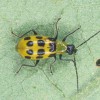 Spotted cucumber beetle is a major agricultural pest of North America. Another name for the spotted cucumber beetle is “southern corn rootworm”. Many Diabrotica species cause damage to field crops, especially corn, making these beetles a major agricultural concern. Because of the subterranean nature of their larvae, these insects are hard and expensive to control. This 6-page fact sheet was written by Harsimran Kaur Gill, Gaurav Goyal, and Jennifer Gillett-Kaufman, and published by the UF Department of Entomology and Nematology, September 2013.
Spotted cucumber beetle is a major agricultural pest of North America. Another name for the spotted cucumber beetle is “southern corn rootworm”. Many Diabrotica species cause damage to field crops, especially corn, making these beetles a major agricultural concern. Because of the subterranean nature of their larvae, these insects are hard and expensive to control. This 6-page fact sheet was written by Harsimran Kaur Gill, Gaurav Goyal, and Jennifer Gillett-Kaufman, and published by the UF Department of Entomology and Nematology, September 2013.
http://edis.ifas.ufl.edu/in1008
’Fairytale Princess’ and ’Red Hot’: Red Lance-leaved Caladium Cultivars
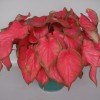 Caladiums are valued in landscapes and containers for their colorful and variable-shaped leaves. Two types of caladium cultivars exist in commercial production: fancy- and lance-leaved. ‘Florida Sweetheart’ is the most popular lance-leaved commercial cultivar of all colors. It produces wide lance leaves with a rosy color and relatively large tubers. ‘Florida Red Ruffles’ is the most popular red, lance-leaved commercial cultivar among caladium growers, greenhouse growers, and nurseries. It has excellent sunburn tolerance. Both cultivars were introduced by the University of Florida (UF) caladium breeding program. This 9-page fact sheet was written by Zhanao Deng, and published by the UF Department of Environmental Horticulture, August 2013.
Caladiums are valued in landscapes and containers for their colorful and variable-shaped leaves. Two types of caladium cultivars exist in commercial production: fancy- and lance-leaved. ‘Florida Sweetheart’ is the most popular lance-leaved commercial cultivar of all colors. It produces wide lance leaves with a rosy color and relatively large tubers. ‘Florida Red Ruffles’ is the most popular red, lance-leaved commercial cultivar among caladium growers, greenhouse growers, and nurseries. It has excellent sunburn tolerance. Both cultivars were introduced by the University of Florida (UF) caladium breeding program. This 9-page fact sheet was written by Zhanao Deng, and published by the UF Department of Environmental Horticulture, August 2013.
http://edis.ifas.ufl.edu/ep481
Food Safety: Does Your Kitchen Pass the Test?
 Older adults are at increased risk for foodborne illness. To help reduce your risk, follow safe food handling practices at home. How does your kitchen measure up? This 3-page fact sheet was written by Linda B. Bobroff and Jennifer Hillan, and published by the UF Department of Family Youth and Community Sciences, October 2013.
Older adults are at increased risk for foodborne illness. To help reduce your risk, follow safe food handling practices at home. How does your kitchen measure up? This 3-page fact sheet was written by Linda B. Bobroff and Jennifer Hillan, and published by the UF Department of Family Youth and Community Sciences, October 2013.
http://edis.ifas.ufl.edu/fy926
New Gerbera Daisy Varieties for Large Containers and Flower Gardens
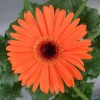 Gerbera daisy is one of the most popular flowers in the United States. Recently, interest has increased in growing gerberas in large containers for indoor or outdoor use. ‘Funtastic™ Tangerine Eye’ and ‘Funtastic™ Golden Eye’ have been selected and tested specifically for use in large containers. These cultivars produce large, powdery mildew-resistant plants and large, attractive flowers in orange-red or yellow-orange that complement the existing Funtastic™ series of gerbera cultivars. This 8-page fact sheet was written by Zhanao Deng, and published by the UF Department of Environmental Horticulture, September 2013.
Gerbera daisy is one of the most popular flowers in the United States. Recently, interest has increased in growing gerberas in large containers for indoor or outdoor use. ‘Funtastic™ Tangerine Eye’ and ‘Funtastic™ Golden Eye’ have been selected and tested specifically for use in large containers. These cultivars produce large, powdery mildew-resistant plants and large, attractive flowers in orange-red or yellow-orange that complement the existing Funtastic™ series of gerbera cultivars. This 8-page fact sheet was written by Zhanao Deng, and published by the UF Department of Environmental Horticulture, September 2013.
http://edis.ifas.ufl.edu/ep482